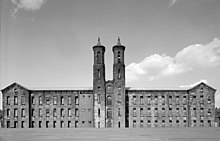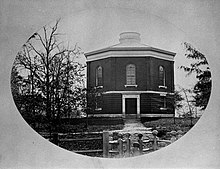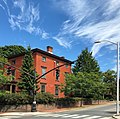Thomas Alexander Tefft | |
|---|---|
 Thomas Alexander Tefft | |
| Born | August 2, 1826 |
| Died | December 12, 1859 (aged 33) |
| Nationality | American |
| Alma mater | Brown University |
| Occupation | Architect |
| Buildings | Cannelton Cotton Mill Narragansett Baptist Church Providence Union Railroad Depot (1847–1896) |



Thomas Alexander Tefft (August 2, 1826 – December 12, 1859) was an American architect, from Providence, Rhode Island. Tefft, one of the nation's first professionally trained architects, is considered a master of Rundbogenstil and a leading American proponent of its use.[1] Prior to his untimely death, Tefft "offered the most advanced designs of [his] day in America"[2]
Life and career
Early life
Tefft was born in rural Richmond, Rhode Island, outside of the small village of Wood River Junction. He was the fourth child of William C. and Sarah Tefft. His family worshiped at the Richmond Six-Principle Baptist Church. During his childhood, Tefft experienced poor health; unable to exert himself physically, he developed an appreciation of books. At the age of 10, he enrolled at a school kept by Elisha Baggs. During his later adolescence, Tefft taught at a local schoolhouse.[3]
During the 1840s, the state school commissioner, Henry Barnard, embarked on an inspection of the state's public schools. Noting Tefft's talents for drawing and the other arts, Barnard convinced him to move to Providence and study architecture. He entered the office of Tallman & Bucklin–then one of the city's primary offices. By 1846, Tefft played a dominant role in the firm's designs. In 1847, he enrolled at Brown University, where he studied under Alexis Caswell.[4][3]
At this time, Tefft exhibited a strong grasp of Rundbogenstil, amassing a large library of books on the style and advocating for its use.[5]
Later career and death
In 1851, Tefft graduated from Brown. At the same time, the partnership of Tallman & Bucklin was dissolved. Tefft then opened his own office, and ran a notable practice that lasted only five years. In 1856, he decided to embark on a grand tour of Europe. Due to the beginning of an economic downturn, the only work that Tefft had in his office were the initial designs of Vassar College. With that project stagnating, he chose to go. He departed on the steamer Arago on December 13, 1856.[3]
He began in England, where he studied the works of Christopher Wren, among others. He also met and was entertained in the home of noted architect Charles Barry. During his tour, Tefft visited the cities of Paris, Rome, Geneva, Berlin, Milan, and Florence, among others.[3] In 1857, he was invited to join the new American Institute of Architects, and was among that organization's first Fellows.[6] In December 1859, he fell ill with a fever in Florence at the home of his friend, the sculptor Hiram Powers. He died there on the 12th. Tefft was first buried in the English Cemetery in Florence; in February 1860 his body was shipped back to Rhode Island, where it was re-interred in Swan Point Cemetery.[7]
Works
With Tallman & Bucklin, 1846–1851
- Barrington School, 351 Nayatt Road, Barrington, RI (1840) – Now a private home[8]

Lawrence Hall, 1846–47 - Butler Hospital, 345 Blackstone Blvd., Providence, RI (1847) – Significantly altered.[10]
- Elisha Dyer House, 11 Greene St., Providence, RI (1847) – Demolished[when?][11]
- Freight House No. 1, Canal St. at Elizabeth, Providence, RI (1847–48) – Served as the passenger station until Union Station was completed. Demolished.[12]
- Gatehouse, Swan Point Cemetery, 585 Blackstone Blvd., Providence, RI (1847) – Demolished.[when?][13]
- Receiving Vault, Swan Point Cemetery, 585 Blackstone Blvd., Providence, RI (1847)[14]
- Second Universalist Church, 151 Weybosset St., Providence, RI (1847–49) – Burned in 2006.[15]
- St. Paul's Episcopal Church, 55 Main St., Wickford, RI (1847)[16]
- Liberty Street School, 10 Liberty St., Warren, RI (1847)[17]
- Allendale School, 545 Woonasquatucket Ave., Allendale, RI (1848)[18]
- Centerdale School, Thomas St., Centerdale, RI (1848) – Demolished.[when?][18]
- Howard's Block, 171 Westminster St., Providence, RI (1848) – Burned in 1853.[19]
- Providence Union Station, Kennedy Plz., Providence, RI (1848) – Burned in 1896.[20]
- Remodeling of House for Richard James Arnold, 124 S. Main St., Providence, RI (1848) – This house was once the Sabin Tavern. Demolished in 1891.[21]
- Union High and Grammar School, 60 High School St., Woonsocket, RI (1848–49) – Burned in 1875.[22][23]
- Young Ladies' High School, 235 Benefit St., Providence, RI (1848).[24]
- Indiana Cotton Mills, 310 Washington St., Cannelton, IN (1849–50) – Now the Cotton Mill Apartments.[25]
- Menzies Sweet House, 12 Arnold St., Providence, RI (1850)[20]
- Narragansett Baptist Church, 170 S. Ferry Rd., South Ferry, RI (1850)
- Pastors' Rest Monument, Swan Point Cemetery, 585 Blackstone Blvd., Providence, RI (1850)[13]
- Remodeling of the Rhode Island State House, 150 Benefit St., Providence, RI (1850)[20]
In private practice, 1851–1856
- New England Screw Co., 1 Henderson St., Providence, RI (c.1851) – Demolished.[26]
- Paris Hill House, 201 Washington St., Providence, RI (1851) – Later the home of the Union Club of Providence. Demolished in 1915.
- St. Thomas Episcopal Church, 1 Smith Ave., Greenville, RI (1851) – Tower added in 1891.[27]
- American Antiquarian Society, 185 Salisbury St., Worcester, MA (1852) – Demolished in 1909.[28]
- Gatehouse, Butler Hospital, 345 Blackstone Blvd., Providence, RI (1852) – Demolished.[when?]
- Taunton Bank Building, 9 Taunton Green, Taunton, MA (1852) – Altered.
- Wakefield Baptist Church, 236 Main St., Wakefield, RI (1852)[29]
- Weeden Block, 41 Westminster St., Providence, RI (c.1852) – Demolished.
- Edward Pearce House, 2 Benevolent St., Providence, RI (1853) – Demolished by the Hope Club for a parking lot in 1960.[30]
- Emily Harper House, 80 Ocean Ave., Newport, RI (1853) – Greatly expanded in the 1870s, Demolished in 1966.
- Howard Block, 171 Westminster St., Providence, RI (1853) – Burned in 1858.[31]
- John B. Palmer House, 151 Waterman St., Providence, RI (1853) – Demolished in 1961.[32]
- Joseph B. Tompkins House, 38 Catherine St., Newport, RI (1853)[33]
- Oakwoods, Oakwoods Dr., Peace Dale, RI (1853) – The home of Rowland Hazard. Demolished.
- Quatrel, 669 Bellevue Ave., Newport, RI (1853–54) – For Earl P. Mason.[33]
- South Baptist Church, 125 Main St., Hartford, CT (1853–54) – Demolished in 1926.

Central Congregational Church,1853-56 - Central Congregational Church, 226 Benefit Street, Providence, RI (1853–56) – purchased and remodeled by RISD[34]
- Tully D. Bowen House, 389 Benefit St., Providence, RI (1853)[20]
- First Baptist Church, 212 S. Washington St., Alexandria, VA (1854) – Significantly altered.[35]
- Henry E. Russell House, Lake St. & Grove Hill, New Britain, CT (1854) – Demolished.
- Richmond College, Grace St., Richmond, VA (1854–55) – Only one wing was ever built to Tefft's design, the rest deviated from his plan. Demolished.[36]
- Richmond Female Institute, N. 10th & E. Marshall Sts., Richmond, VA (1854) – Demolished in 1924.[37]
- Robert Lippitt House, 193 Hope St., Providence, RI (1854)[20]
- William Slater House, Halliwell Blvd., Slatersville, RI (1854) – Demolished.
- Charles Potter House, 154 Waterman St., Providence, RI (1855) – Remodeled c.1900.[20]
- Charles S. Bradley House, 249 Eaton St., Providence, RI (1855) – Now Providence College's Martin Hall.[20]
- Elmhurst, 700 Smith St., Providence, RI (1855) – A house for William Grosvenor that lent the neighborhood its name. Burned in 1967.[20]
- John Carter Brown II Stable, 357 Benevolent St., Providence, RI (1855)[20]
- Proposal for Providence City Hall, 25 Dorrance St., Providence, RI (1855) – Not built.[38]
- Roger Williams Free Baptist Church, 1076 Westminster St., Providence, RI (1855) – Demolished.[39]
- Bank of North America Building, 48 Weybosset St., Providence, RI (1856) – Ground floor altered.[20]
- Central Baptist Church, Weybosset St. at Empire, Providence, RI (1856) – Demolished in 1915 for the new Empire Street.[20]
- Proposal for Providence Merchants Exchange Building, 76 Westminster St., Providence, RI (1856) – An unusual circular building, not built.[38]
- Proposal for Vassar College, Poughkeepsie, NY – Not built due to economic troubles. The commission would later go to Renwick, Auchmuty & Sands of New York.[40]
- Seth Padelford Stable, 17 Benevolent St., Providence, RI (1856) – Demolished in 1955.[38]
Gallery
-
School House (1840), Barrington RI
-
Providence Union Station (1847)
-
Freight House (1848), Providence
-
Cannelton Cotton Mill (1851), Cannelton, I.N.
-
Narragansett Baptist Church (1850), Narraganset, R.I.
-
Tully Bowen House (1853), Providence
-
Edward Pearce House (1853), Providence
-
Richmond Female Institute (1854), Richmond, V.A.
-
Robert Lippitt House (1854), Providence
-
Martin Hall, Providence College (1855), Providence
-
Charles Potter House (1855), Providence
-
Proposal for Providence City Hall (1855)
-
Central Baptist Church (1856), Providence
-
Proposal for Providence Merchants Exchange Building (1856)
References
- ^ Bradley, Former Teacher in the Historic Preservation Program Betsy Hunter; Bradley, Betsy H. (1999). The Works: The Industrial Architecture of the United States. Oxford University Press. p. 235. ISBN 978-0-19-509000-0.
- ^ Curran, Kathleen (1988). "The German Rundbogenstil and Reflections on the American Round-Arched Style". Journal of the Society of Architectural Historians. 47 (4): 351–373. doi:10.2307/990381. ISSN 0037-9808. JSTOR 990381.
- ^ a b c d Stone, Edwin Martin (1869). The Architect and Monetarian: A Brief Memoir of Thomas Alexander Tefft, Including His Labors in Europe to Establish a Universal Currency. S. S. Rider and brother. ISBN 978-0-608-39931-7.
- ^ Austin, Nancy (2010-09-11). "Ecology Of Culture: Was Tefft coming back?". Ecology Of Culture. Retrieved 2021-03-31.
- ^ Curran, Kathleen (2003). The romanesque revival: religion, politics, and transnational exchange. University Park, Penn.: Pennsylvania State University Press. p. 139. ISBN 978-0-271-02215-4. OCLC 49844681.
- ^ Thomas Alexander Tefft: American Architecture in Transition (Providence: Brown University Department of Art, 1988)
- ^ Richmond Historical Society; Richmond Bicentennial Commission (1977). Driftways into the past: local history of the town of Richmond, Rhode Island, as remembered and visualized by members of the Richmond Historical Society and the Richmond Bicentennial Commission. Richmond, R.I.: Richmond Historical Society. OCLC 4003334.
- ^ Dunn, Christine. "House of the Week: Historical charm, modern amenities in Barrington home". providencejournal.com. Retrieved 2021-03-31.
- ^ Art, Williams College Museum of (2001). American Dreams: American Art to 1950 in the Williams College Museum of Art. Hudson Hills. ISBN 978-1-55595-210-5.
- ^ Page 362, The Grove Encyclopedia of American Art, Vol. 2 (Joan Marter, ed., 2011)
- ^ Page 102, Transactions of the Rhode Island Society for the Encouragement of Domestic Industry in the Year 1859 (1860)
- ^ "Providence & Worcester Railroad Merchandise House No. 1". Rhode Island ArtInRuins. Retrieved 2024-12-14.
- ^ a b "Welcome to a History of Swan Point Cemetery History Project". www.lahistoryarchive.org. Retrieved 2021-03-31.
- ^ "Swan Point Cemetery // Guide to Providence Architecture". guide.ppsri.org. Retrieved 2021-03-31.
- ^ Brussat, David (2017). Lost Providence. Arcadia. p. 71. ISBN 978-1-4671-3724-9. OCLC 982538921.
- ^ "NRHP nomination for St. Paul's Church" (PDF). Rhode Island Preservation. September 15, 1971.
- ^ Warren, Elizabeth S. (1975). Warren, Rhode Island (PDF). Statewide Preservation Report. p. 21.
- ^ a b Page 99, Proceedings of the Rhode Island Historical Society, 1873–74 (1874)
- ^ Sheila Lennon (January 25, 2013). "Long ago, it housed a business school: Where, when, what's there now?". The Providence Journal. Retrieved 2014-12-22.
- ^ a b c d e f g h i j k Woodward, William McKenzie (1986). Providence : a citywide survey of historic resources. Edward F. Sanderson, David, April 5- Chase, Rhode Island Historical Preservation Commission. [Providence]: Rhode Island Historical Preservation Commission. ISBN 0-939261-12-X. OCLC 16357627.
- ^ Hoffmann, Charles G; Hoffmann, Tess (2009). North by South: The Two Lives of Richard James Arnold. Athens: University of Georgia Press. p. 112. ISBN 978-0-8203-3443-1. OCLC 713599391.
- ^ Richardson, Erastus. History of Woonsocket. 1876.
- ^ Barnard, Henry. School Architecture. 1850.
- ^ "Education for Everybody: Brown's Innovation and Influence in Collegiate Education". Archived from the original on 2014-12-09. Retrieved 2014-12-06.
- ^ Wriston, Barbara (1965). "Who Was the Architect of the Indiana Cotton Mill, 1849-1850?". Journal of the Society of Architectural Historians. 24 (2): 171–173. doi:10.2307/988300. ISSN 0037-9808. JSTOR 988300.
- ^ "American Screw Company". Rhode Island ArtInRuins. Retrieved 2024-12-14.
- ^ Page 60, Historic and Architectural Resources of Smithfield, Rhode Island (RIHPC, 1992)
- ^ "Worcester Antiquarian Society", Norton's Literary Gazette (November 15, 1852)
- ^ Page 381, Buildings of Rhode Island (William H. Jordy, 2004)
- ^ "Records of #2 Benevolent Street" (PDF). Providence Preservation Society.
- ^ Lennon, Sheila. "Long ago, it housed a business school: Where, when, what's there now?". providencejournal.com. Retrieved 2021-03-31.
- ^ Page 167, Providence: A Citywide Survey of Historic Resources (Wm. McKenzie Woodward, 1986)
- ^ a b Yarnall, James L. (2005). Newport through its architecture : a history of styles from postmedieval to postmodern. Newport, R.I.: Salve Regina University Press in association with University Press of New England, Hanover and London. ISBN 1-58465-491-0. OCLC 57754204.
- ^ Conley, Patrick T. (2012-07-24). The Makers of Modern Rhode Island. Arcadia Publishing. ISBN 978-1-61423-608-5.
- ^ Wilson, Richard Guy; Butler, Sara A (2002). Buildings of Virginia: Tidewater and Piedmont. New York: Oxford University Press. p. 85. ISBN 978-0-19-515206-7. OCLC 48468655.
- ^ Page 151, Virginia Baptist Ministers, Vol. 3 (George Braxton Taylor, 1912)
- ^ Wingfield Scott, Mary. "Old Richmond Neighborhoods" (PDF). www.rosegill.com.
- ^ a b c Jordy, William H; Monkhouse, Christopher P; David Winton Bell Gallery (Brown University) (1982). Buildings on paper: Rhode Island architectural drawings, 1825-1945. Providence, Rhode Island: Bell Gallery, List Art Center, Brown University. OCLC 8762607.
- ^ Greene, Welcome Arnold (1886). The Providence Plantations for Two Hundred and Fifty Years: An Historical Review of the Foundation, Rise and Progress of the City of Providence. J. A. & R. A. Reid. OCLC 924704.
- ^ Page 31, Alma Mater: Design and Experience in the Women's Colleges (Helen Lefkowitz Horowitz, 1984)
External links
- The Architect and Monetarian: A Brief Memoir of Thomas Alexander Tefft by Edward Martin Stone (1869). Full text. Retrieved 9 December 2014.
- Thomas Alexander Tefft: Architect Extraordinaire. Retrieved 9 December 2014.
- Thomas Alexander Tefft at Find a Grave
























